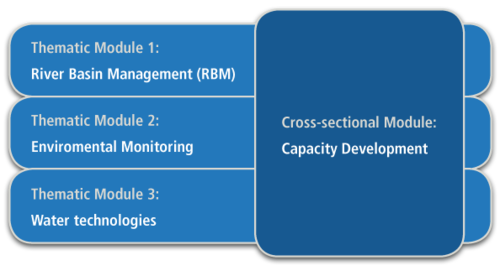Integrated Water Resources Management for Central Asia: Model Region Mongolia (MoMo)
The Kharaa river basin suffers from a series of problems, including the effects of global climate change, diffuse pollution, mining impacts, lacks of adequate water supply and sanitation infrastructure in the rural and urban context, endangered ecological functions of rivers and continuing deterioration of riparian land resources. These are well representative of the difficulties faced in other river catchments in Mongolia and Central Asia.
The IWRM project was a joint co-operation of research institutes and administrations from Mongolia and Germany that aimed at creating a scientifically sound knowledge base that could serve as model for improved IWRM in Mongolia and the region. The ultimate objective is the implementation of integrative solutions to these problems through the practical realization of an IWRM.
An IWRM concept will initially be developed, adapted and implemented for the catchment of the Kharaa River in the northeast of Mongolia. The work is organized as a multilateral interdisciplinary collaboration which takes into account the specific conditions in different subregions of the catchment. Building on the results of MoMo Phase I (2006-2009) and MoMo Phase II (2010-2014), the third phase (2015-2018) will work on the implementation of water management measures.
The highly dynamic hydrological situation in the region, shortages in water quantity and problems related to water quality have to be investigated in the contexts of the physical and socio-economic environment and their interrelations. The (combined) effects of ongoing trends, measures planned by the project and external interventions need to be understood.
Capacity building for planners, decision makers and actors at various levels is necessary to generate the local competence required to sustainably manage the water resources in the Kharaa river basin and throughout Mongolia.
Technical solutions, which are well adjusted to the extreme climatic situation, the given state of the infrastructure and the socio-economic environment need to be developed and tested. These include both decentralized approaches for sparsely settled rural regions and solutions for improving water supply and wastewater disposal in urban regions.
Because mining for mineral resources (esp. gold and copper) plays a major role in the region and nationwide, water management practices in the mining sector are included in the project. These include operative monitoring schemes and guidelines for environmental sound exploration of mineral resources.
- Study area - The Kharaa River Basin
- Module 1: River basin management
- Module 2: Monitoring of water quantity, quality and ecological status
- Module 3: Water technologies
- Cross-sectional module: Capacity building
- Planned activities – Outlook
All content regarding to the IWRM project MoMo in Mongolia was taken from the following sources:
MoMo Consortium (2016): The IWRM MoMo Project. http://www.iwrm-momo.de/contact.htm
MoMo Consortium (2009): MoMo – IWRM in Central Asia. Model Region Mongolia (MoMo): Case Study in the Kharaa River Basin. Final Project Report
Karthe, D. & Borchardt, D. (Eds.) (2012): Integrated Water Resources Management: Model Region Mongolia. Project Profile
Ilian, J. & Scharaw, B. (2012): MoMo Fact Sheet. Decentralized Waste Water Management: Experiences from Pilot Operation in Orkhon Sum
Sullivan, C. & van Afferden, M. (2012): MoMo Fact Sheet. Waste Water Treatment Plant with Integrated Wood Production.
Wesenfeld H.& B. Scharaw, B. (2012): MoMo Fact Sheet. SBR pilot plant on the central wastewater treatment plant in Darkhan City.
Stäudel, J.: Seyfarth, R. & Londong, J. (2012): MoMo Fact Sheet. iPiT - integrated Personal innovative Toilet.
